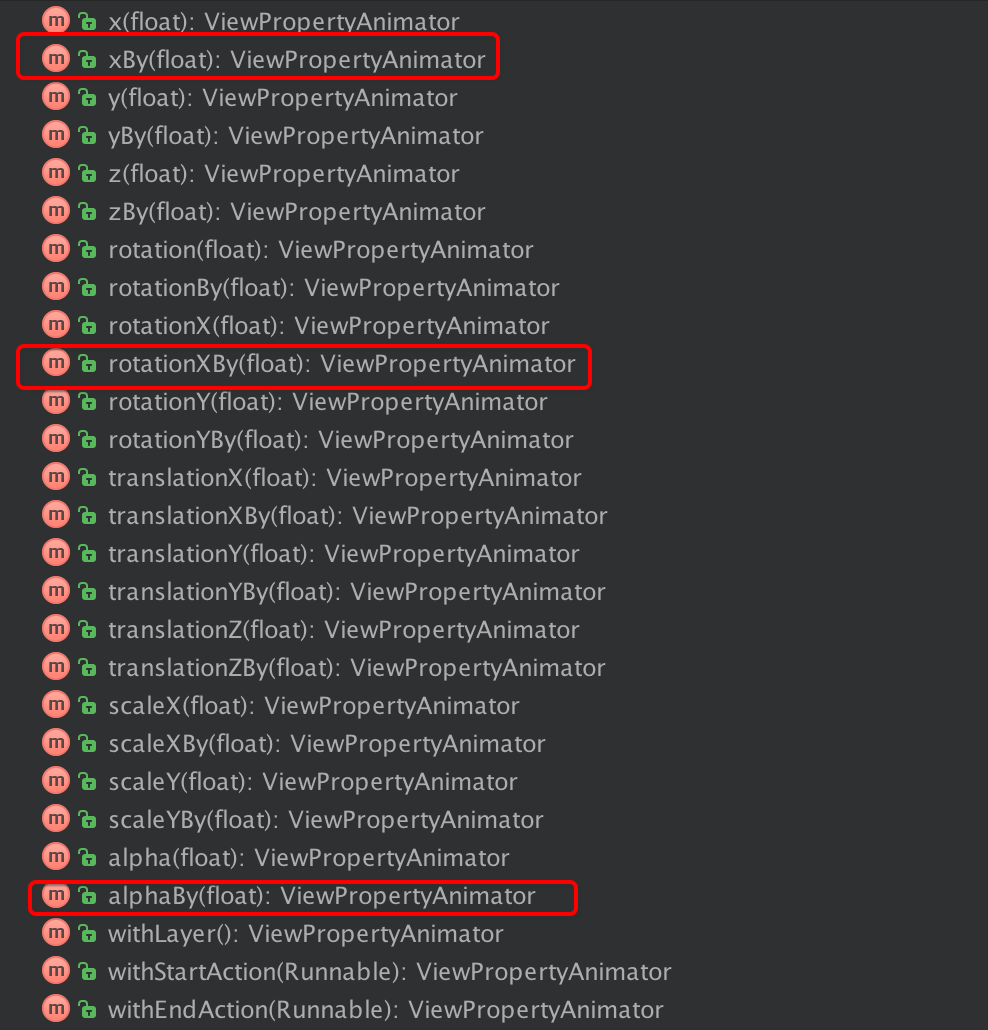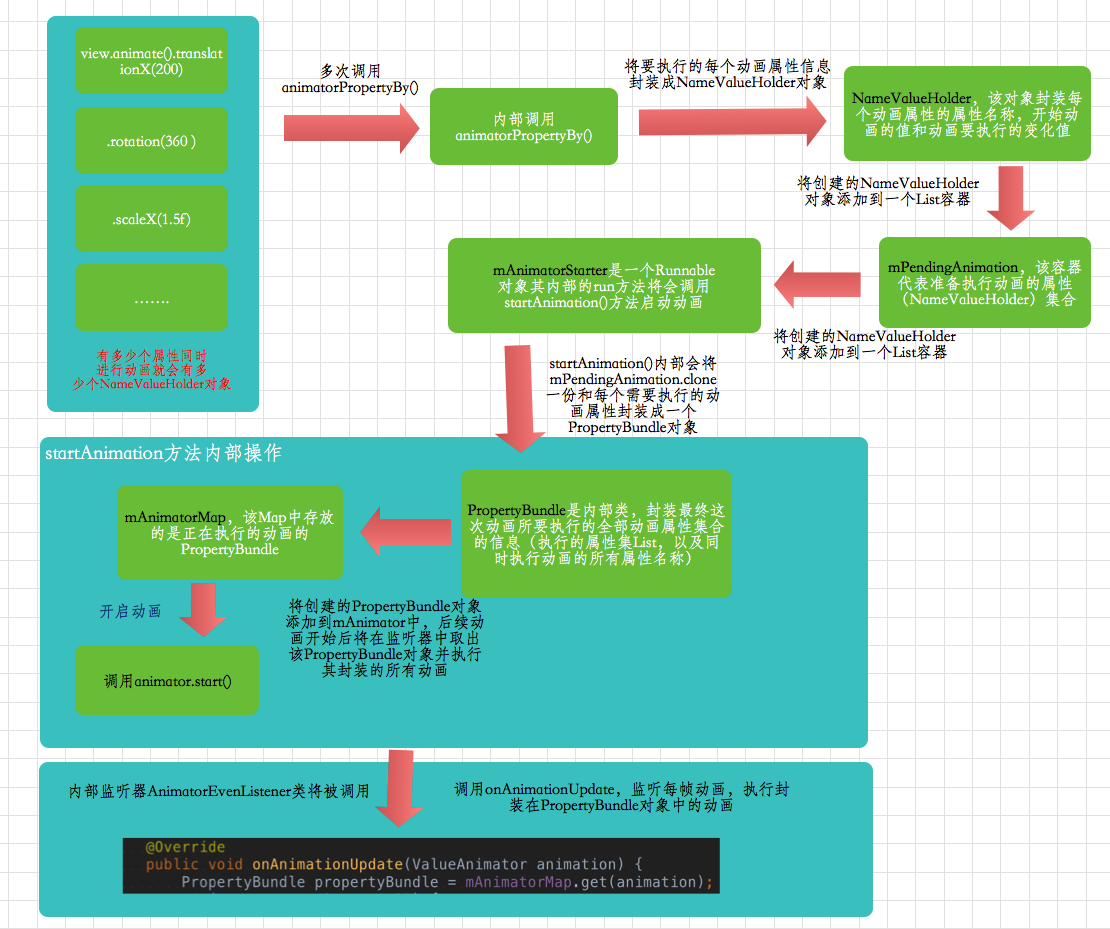转载请注明出处(万分感谢!):
http://blog.csdn.net/javazejian/article/details/52381558
出自【zejian的博客】
关联文章:
走进绚烂多彩的属性动画-Property Animation(上篇)
走进绚烂多彩的属性动画-Property Animation之Interpolator和TypeEvaluator(下篇)
属性动画-Property Animation之ViewPropertyAnimator 你应该知道的一切
Android布局动画之animateLayoutChanges与LayoutTransition
原本打算这篇作为属性动画的完结篇,但目前情况来看,估计无法完结,前两天研究了一下ViewPropertyAnimator这个android 3.1版本后新添加的类,感觉挺有必要用一篇文章来记录一下这个类,ViewPropertyAnimator本身也算不上什么高级类,自然也不是什么特殊技巧,那这个类到底是用来干什么的呢?这就是我们本篇的目的所在啦,接下来我们就来全面地了解一下ViewPropertyAnimator
1.ViewPropertyAnimator概述
通过前两篇的学习,我们应该明白了属性动画的推出已不再是针对于View而进行设计的了,而是一种对数值不断操作的过程,我们可以将属性动画对数值的操作过程设置到指定对象的属性上来,从而形成一种动画的效果。虽然属性动画给我们提供了ValueAnimator类和ObjectAnimator类,在正常情况下,基本都能满足我们对动画操作的需求,但ValueAnimator类和ObjectAnimator类本身并不是针对View对象的而设计的,而我们在大多数情况下主要都还是对View进行动画操作的,因此Google官方在Android 3.1系统中补充了ViewPropertyAnimator类,这个类便是专门为View动画而设计的。当然这个类不仅仅是为提供View而简单设计的,它存在以下优点:
- 专门针对View对象动画而操作的类。
- 提供了更简洁的链式调用设置多个属性动画,这些动画可以同时进行的。
- 拥有更好的性能,多个属性动画是一次同时变化,只执行一次UI刷新(也就是只调用一次invalidate,而n个ObjectAnimator就会进行n次属性变化,就有n次invalidate)。
- 每个属性提供两种类型方法设置。
- 该类只能通过View的animate()获取其实例对象的引用
好~,下面我们来了解一下ViewPropertyAnimator常规使用
2.ViewPropertyAnimator常规使用
之前我们要设置一个View控件旋转360的代码是这样:
ObjectAnimator.ofFloat(btn,"rotation",360).setDuration(200).start();而现在我们使用ViewPropertyAnimator后是这样:
btn.animate().rotation(360).setDuration(200); 代码是不是特简洁?这里我们来解析一下,首先必须用View#animate()方法来获取一个ViewPropertyAnimator的对象实例,前面我们说过ViewPropertyAnimator支持链式操作,所以这里直接通过rotation方法设置旋转角度,再设置时间即可,有没有发现连动画的启动都不用我们去操作!是的,ViewPropertyAnimator内部会自动去调用
对于View#animate()方法,这里再说明一下,animate()方法是在Android 3.1系统上新增的一个方法,其作用就是返回ViewPropertyAnimator的实例对象,其源码如下,一目了然:
/**
* This method returns a ViewPropertyAnimator object, which can be used to animate
* specific properties on this View.
*
* @return ViewPropertyAnimator The ViewPropertyAnimator associated with this View.
*/
public ViewPropertyAnimator animate() {
if (mAnimator == null) {
mAnimator = new ViewPropertyAnimator(this);
}
return mAnimator;
}接着我们再来试试别的方法,同时设置一组动画集合如下:
AnimatorSet set = new AnimatorSet();
set.playTogether( ObjectAnimator.ofFloat(btn,"alpha",0.5f),
ObjectAnimator.ofFloat(btn,"rotation",360),
ObjectAnimator.ofFloat(btn,"scaleX",1.5f),
ObjectAnimator.ofFloat(btn,"scaleY",1.5f),
ObjectAnimator.ofFloat(btn,"translationX",0,50),
ObjectAnimator.ofFloat(btn,"translationY",0,50)
);
set.setDuration(5000).start();使用ViewPropertyAnimator设置代码如下:
btn.animate().alpha(0.5f).rotation(360).scaleX(1.5f).scaleY(1.5f)
.translationX(50).translationY(50).setDuration(5000);是不是已经深深地爱上ViewPropertyAnimator?真的太简洁了!都快感动地哭出来了……先去厕所哭会…….好吧,ViewPropertyAnimator简单用法讲完了,这里小结一下ViewPropertyAnimator的常用方法:
| Method | Discription |
|---|---|
| alpha(float value) | 设置透明度,value表示变化到多少,1不透明,0全透明。 |
| scaleY(float value) | 设置Y轴方向的缩放大小,value表示缩放到多少。1表示正常规格。小于1代表缩小,大于1代表放大。 |
| scaleX(float value) | 设置X轴方向的缩放大小,value表示缩放到多少。1表示正常规格。小于1代表缩小,大于1代表放大。 |
| translationY(float value) | 设置Y轴方向的移动值,作为增量来控制View对象相对于它父容器的左上角坐标偏移的位置,即移动到哪里。 |
| translationX(float value) | 设置X轴方向的移动值,作为增量来控制View对象相对于它父容器的左上角坐标偏移的位置。 |
| rotation(float value) | 控制View对象围绕支点进行旋转, rotation针对2D旋转 |
| rotationX (float value) | 控制View对象围绕X支点进行旋转, rotationX针对3D旋转 |
| rotationY(float value) | 控制View对象围绕Y支点进行旋转, rotationY针对3D旋转 |
| x(float value) | 控制View对象相对于它父容器的左上角坐标在X轴方向的最终位置。 |
| y(float value) | 控制View对象相对于它父容器的左上角坐标在Y轴方向的最终位置 |
| void cancel() | 取消当前正在执行的动画 |
| setListener(Animator.AnimatorListener listener) | 设置监听器,监听动画的开始,结束,取消,重复播放 |
| setUpdateListener(ValueAnimator.AnimatorUpdateListener listener) | 设置监听器,监听动画的每一帧的播放 |
| setInterpolator(TimeInterpolator interpolator) | 设置插值器 |
| setStartDelay(long startDelay) | 设置动画延长开始的时间 |
| setDuration(long duration) | 设置动画执行的时间 |
| withLayer() | 设置是否开启硬件加速 |
| withStartAction(Runnable runnable) | 设置用于动画监听开始(Animator.AnimatorListener)时运行的Runnable任务对象 |
| withEndAction(Runnable runnable) | 设置用于动画监听结束(Animator.AnimatorListener)时运行的Runnable任务对象 |
以上便是ViewPropertyAnimator一些操作方法,其实上面很多属性设置方法都对应着一个By结尾的方法,其变量则代表的是变化量,如下:

我们看看其中scaleY与scaleYBy的实现:
public ViewPropertyAnimator scaleY(float value) {
animateProperty(SCALE_Y, value);
return this;
}
public ViewPropertyAnimator scaleYBy(float value) {
animatePropertyBy(SCALE_Y, value);
return this;
}再看看animateProperty()与 animatePropertyBy()
private void animateProperty(int constantName, float toValue) {
float fromValue = getValue(constantName);
float deltaValue = toValue - fromValue;
animatePropertyBy(constantName, fromValue, deltaValue);
}
private void animatePropertyBy(int constantName, float byValue) {
float fromValue = getValue(constantName);
animatePropertyBy(constantName, fromValue, byValue);
} 看了源码现在应该很清楚有By结尾(代表变化量的大小)和没By结尾(代表变化到多少)的方法的区别了吧。好~,再来看看监听器,实际上我们可以通过setListener(Animator.AnimatorListener listener)和setUpdateListener(ValueAnimator.AnimatorUpdateListener listener)设置自定义监听器,而在ViewPropertyAnimator内部也有自己实现的监听器,同样我们可以看一下其实现源码:
private class AnimatorEventListener
implements Animator.AnimatorListener, ValueAnimator.AnimatorUpdateListener {
@Override
public void onAnimationStart(Animator animation) {
//调用了设置硬件加速的Runnable
if (mAnimatorSetupMap != null) {
Runnable r = mAnimatorSetupMap.get(animation);
if (r != null) {
r.run();
}
mAnimatorSetupMap.remove(animation);
}
if (mAnimatorOnStartMap != null) {
//调用我们通过withStartAction(Runnable runnable)方法设置的runnable
Runnable r = mAnimatorOnStartMap.get(animation);
if (r != null) {
r.run();
}
mAnimatorOnStartMap.remove(animation);
}
if (mListener != null) {
//调用我们自定义的监听器方法
mListener.onAnimationStart(animation);
}
}
@Override
public void onAnimationCancel(Animator animation) {
if (mListener != null) {
//调用我们自定义的监听器方法
mListener.onAnimationCancel(animation);
}
if (mAnimatorOnEndMap != null) {
mAnimatorOnEndMap.remove(animation);
}
}
@Override
public void onAnimationRepeat(Animator animation) {
if (mListener != null) {
//调用我们自定义的监听器方法
mListener.onAnimationRepeat(animation);
}
}
@Override
public void onAnimationEnd(Animator animation) {
mView.setHasTransientState(false);
if (mListener != null) {
//调用我们自定义的监听器方法
mListener.onAnimationEnd(animation);
}
if (mAnimatorOnEndMap != null) {
//调用我们通过withEndAction(Runnable runnable)方法设置的runnable
Runnable r = mAnimatorOnEndMap.get(animation);
if (r != null) {
r.run();
}
mAnimatorOnEndMap.remove(animation);
}
if (mAnimatorCleanupMap != null) {
//移除硬件加速
Runnable r = mAnimatorCleanupMap.get(animation);
if (r != null) {
r.run();
}
mAnimatorCleanupMap.remove(animation);
}
mAnimatorMap.remove(animation);
} 由源码我们知道当监听器仅需要监听动画的开始和结束时,我们可以通过withStartAction(Runnable runnable)和withEndAction(Runnable runnable)方法来设置一些特殊的监听操作。在AnimatorEventListener中的开始事件还会判断是否开启硬件加速,当然在动画结束时也会去关闭硬件加速。我们可以通过ViewPropertyAnimator #withLayer()方法开启硬件加速功能。到此对于ViewPropertyAnimator的常规使用方式已很清晰了。剩下的我们就来剖析剖析ViewPropertyAnimator内部到底是如何运作的,同时又是如何优化动画性能的。
3.ViewPropertyAnimator原理解析
我们先通过一副图来大概了解一下ViewPropertyAnimator内部的整体运行工作原理(图太小的话请右键在新页面打开哈,不知为什么markdown限制了大小 。。郁闷中。。):

我们这里先给出整体执行流程(有个整体的概念就行哈,不理解也没有关系,看完下面的分析,再回来来看看也是可以),然后再详细分析:
- 1.通过imageView.animate()获取ViewPropertyAnimator对象。
- 2.调用alpha、translationX等方法,返回当前ViewPropertyAnimator对象,可以继续链式调用
- 3.alpha、translationX等方法内部最终调用animatePropertyBy(int constantName, float startValue, float byValue)方法
- 4.在animatePropertyBy方法中则会将alpha、translationX等方法的操作封装成NameVauleHolder,并将每个NameValueHolder对象添加到准备列表mPendingAnimations中。
- 5.animatePropertyBy方法启动mAnimationStarter,调用startAnimation,开始动画。
- 6.startAnimation方法中会创建一个ValueAnimator对象设置内部监听器AnimatorEventListener,并将mPendingAnimations和要进行动画的属性名称封装成一个PropertyBundle对象,最后mAnimatorMap保存当前Animator和对应的PropertyBundle对象。该Map将会在animatePropertyBy方法和Animator监听器mAnimatorEventListener中使用,启动动画。
- 7.在动画的监听器的onAnimationUpdate方法中设置所有属性的变化值,并通过RenderNode类优化绘制性能,最后刷新界面。
有了整体概念后,现在我们沿着该工作流程图的路线来分析ViewPropertyAnimator内部执行过程,从上图可以看出,通过View#animate()获取到ViewPropertyAnimator实例后,可以通过ViewPropertyAnimator提供的多种方法来设置动画,如translationX()、scaleX()等等,而当调用完这些方法后,其内部最终则会通过多次调用animatorPropertyBy(),我们先看看animatePropertyBy方法源码:
/**
* Utility function, called by animateProperty() and animatePropertyBy(), which handles the
* details of adding a pending animation and posting the request to start the animation.
*
* @param constantName The specifier for the property being animated
* @param startValue The starting value of the property
* @param byValue The amount by which the property will change
*/
private void animatePropertyBy(int constantName, float startValue, float byValue) {
// First, cancel any existing animations on this property
//判断该属性上是否存在运行的动画,存在则结束。
if (mAnimatorMap.size() > 0) {
Animator animatorToCancel = null;
Set<Animator> animatorSet = mAnimatorMap.keySet();
for (Animator runningAnim : animatorSet) {
PropertyBundle bundle = mAnimatorMap.get(runningAnim);
if (bundle.cancel(constantName)) {// 结束对应属性动画
// property was canceled - cancel the animation if it's now empty
// Note that it's safe to break out here because every new animation
// on a property will cancel a previous animation on that property, so
// there can only ever be one such animation running.
if (bundle.mPropertyMask == NONE) {//判断是否还有其他属性
// the animation is no longer changing anything - cancel it
animatorToCancel = runningAnim;
break;
}
}
}
if (animatorToCancel != null) {
animatorToCancel.cancel();
}
}
//将要执行的属性的名称,开始值,变化值封装成NameValuesHolder对象
NameValuesHolder nameValuePair = new NameValuesHolder(constantName, startValue, byValue);
//添加到准备列表中
mPendingAnimations.add(nameValuePair);
mView.removeCallbacks(mAnimationStarter);
mView.postOnAnimation(mAnimationStarter);
}从源码可以看出,animatePropertyBy方法主要干了以下几件事:
- 首先会去当前属性是否还有在动画在执行,如果有则先结束该属性上的动画,保证该属性上只有一个Animator在进行动画操作。
- 将本次动画需要执行的动画属性封装成一个NameValueHolder对象
- 将每个NameValuesHolder对象添加到mPendingAnimations的准备列表中
NameValuesHolder对象是一个内部类,其相关信息如下:
NameValueHolder:内部类,封装每个要进行动画属性值开始值和变化值,比如translationX(200),那么这个动画的属性值、开始值和变化值将被封装成一个NameValueHolder,其源码也非常简单:
static class NameValuesHolder {
int mNameConstant;//要进行动画的属性名称
float mFromValue;//开始值
float mDeltaValue;//变化值
NameValuesHolder(int nameConstant, float fromValue, float deltaValue) {
mNameConstant = nameConstant;
mFromValue = fromValue;
mDeltaValue = deltaValue;
}
} 而mPendingAnimations的相关信息如下:
mPendingAnimations:装载的是准备进行动画的属性值(NameValueHolder)所有列表,也就是每次要同时进行动画的全部属性的集合
ArrayList<NameValuesHolder> mPendingAnimations = new ArrayList<NameValuesHolder>(); 当添加完每个要运行的属性动画后,则会通过mAnimationStarter对象去调用startAnimation(),启动动画。
Runnable mAnimationStarter: 用来执行动画的Runnable。它会执行startAnimation方法,而在startAnimation方法中会通过animator.start()启动动画,源码非常简洁:
private Runnable mAnimationStarter = new Runnable() {
@Override
public void run() {
startAnimation();
}
};接着我们看看startAnimation()的源码:
/**
* Starts the underlying Animator for a set of properties. We use a single animator that
* simply runs from 0 to 1, and then use that fractional value to set each property
* value accordingly.
*/
private void startAnimation() {
if (mRTBackend != null && mRTBackend.startAnimation(this)) {
return;
}
mView.setHasTransientState(true);
//创建ValueAnimator
ValueAnimator animator = ValueAnimator.ofFloat(1.0f);
//clone一份mPendingAnimations赋值给nameValueList
ArrayList<NameValuesHolder> nameValueList =
(ArrayList<NameValuesHolder>) mPendingAnimations.clone();
//赋值完后清空
mPendingAnimations.clear();
//用于标识要执行动画的属性
int propertyMask = 0;
int propertyCount = nameValueList.size();
//遍历所有nameValuesHolder,取出其属性名称mNameConstant,
//执行"|"操作并最终赋值propertyMask
for (int i = 0; i < propertyCount; ++i) {
NameValuesHolder nameValuesHolder = nameValueList.get(i);
propertyMask |= nameValuesHolder.mNameConstant;
}
//创建PropertyBundle,并添加到mAnimatorMap中
mAnimatorMap.put(animator, new PropertyBundle(propertyMask, nameValueList));
if (mPendingSetupAction != null) {
//设置硬件加速
mAnimatorSetupMap.put(animator, mPendingSetupAction);
mPendingSetupAction = null;
}
if (mPendingCleanupAction != null) {
//移除硬件加速
mAnimatorCleanupMap.put(animator, mPendingCleanupAction);
mPendingCleanupAction = null;
}
if (mPendingOnStartAction != null) {
//设置开始的动画(监听器的开始方法中调用)
mAnimatorOnStartMap.put(animator, mPendingOnStartAction);
mPendingOnStartAction = null;
}
if (mPendingOnEndAction != null) {
//设置结束后要进行的下一个动画(监听器的结束方法中调用)
mAnimatorOnEndMap.put(animator, mPendingOnEndAction);
mPendingOnEndAction = null;
}
//添加内部监听器
animator.addUpdateListener(mAnimatorEventListener);
animator.addListener(mAnimatorEventListener);
//判断是否延长开始
if (mStartDelaySet) {
animator.setStartDelay(mStartDelay);
}
//执行动画的实现
if (mDurationSet) {
animator.setDuration(mDuration);
}
//设置插值器
if (mInterpolatorSet) {
animator.setInterpolator(mInterpolator);
}
//开始执行动画
animator.start();
} 我们上面的注释非常全面,这里startAnimation主要做下面几件事:
- 创建Animator,变化值从0到1,设置内部监听器mAnimatorEventListener。
- clone一份mPendingAnimations列表,并计算属性值标记propertyMask,封装成PropertyBundle对象。
- 使用mAnimatorMap保存当前Animator和对应的PropertyBundle对象。该Map将会在animatePropertyBy方法和Animator监听器mAnimatorEventListener中使用。
- 启动animator动画。
关于PropertyBundle的分析如下:
PropertyBundle: 内部类,存放着将要执行的动画的属性集合信息,每次调用animator.start();前,都会将存放在mPendingAnimations的clone一份存入PropertyBundle的内部变量mNameValuesHolder中,然后再将遍历mPendingAnimations中的NameValueHolder类,取出要执行的属性进行”|”操作,最后记录成一个mPropertyMask的变量,存放在PropertyBundle中,PropertyBundle就是最终要执行动画的全部属性的封装类,其内部结构如下图
AnimatorEventListener: ViewPropertyAnimator内部的监听器。这个类实现了Animator.AnimatorListener, ValueAnimator.AnimatorUpdateListener接口。我们前面已经分享过它的部分源码,这个类还有一个onAnimationUpdate()的监听方法,这个方法我们放在后面解析,它是动画执行的关键所在。
HashMap mAnimatorMap: 存放PropertyBundle类的Map。这个Map中存放的是正在执行的动画的PropertyBundle,这个PropertyBundle包含这本次动画的所有属性的信息。最终在AnimatorEventListener的onAnimationUpdate()方法中会通过这个map获取相应的属性,然后不断更新每帧的属性值以达到动画效果。通过前面对animatePropertyBy方法的分析,我们可以知道该Map会保证当前只有一个Animator对象对该View的属性进行操作,不会存在两个Animator在操作同一个属性,其声明如下:
private HashMap<Animator, PropertyBundle> mAnimatorMap =
new HashMap<Animator, PropertyBundle>();最后我们看看动画是在哪里执行的,根据我们前面的原理图,内部监听器的onAnimationUpdate()方法将会被调用(当然内部监听器AnimatorEventListener实现了两个动画监听接口,其开始,结束,重复,取消4个方法也会被调用,这个我们前面已分析过)。
@Override
public void onAnimationUpdate(ValueAnimator animation) {
//取出当前Animator对应用propertyBundle对象
PropertyBundle propertyBundle = mAnimatorMap.get(animation);
if (propertyBundle == null) {
// Shouldn't happen, but just to play it safe
return;
}
//是否开启了硬件加速
boolean hardwareAccelerated = mView.isHardwareAccelerated();
// alpha requires slightly different treatment than the other (transform) properties.
// The logic in setAlpha() is not simply setting mAlpha, plus the invalidation
// logic is dependent on how the view handles an internal call to onSetAlpha().
// We track what kinds of properties are set, and how alpha is handled when it is
// set, and perform the invalidation steps appropriately.
boolean alphaHandled = false;
if (!hardwareAccelerated) {
mView.invalidateParentCaches();
}
//取出当前的估算值(插值器计算值)
float fraction = animation.getAnimatedFraction();
int propertyMask = propertyBundle.mPropertyMask;
if ((propertyMask & TRANSFORM_MASK) != 0) {
mView.invalidateViewProperty(hardwareAccelerated, false);
}
//取出所有要执行的属性动画的封装对象NameValuesHolder
ArrayList<NameValuesHolder> valueList = propertyBundle.mNameValuesHolder;
if (valueList != null) {
int count = valueList.size();
//遍历所有NameValuesHolder,计算变化值,并设置给对应的属性
for (int i = 0; i < count; ++i) {
NameValuesHolder values = valueList.get(i);
float value = values.mFromValue + fraction * values.mDeltaValue;
if (values.mNameConstant == ALPHA) {
alphaHandled = mView.setAlphaNoInvalidation(value);
} else {
setValue(values.mNameConstant, value);
}
}
}
if ((propertyMask & TRANSFORM_MASK) != 0) {
if (!hardwareAccelerated) {
mView.mPrivateFlags |= View.PFLAG_DRAWN; // force another invalidation
}
}
// invalidate(false) in all cases except if alphaHandled gets set to true
// via the call to setAlphaNoInvalidation(), above
if (alphaHandled) {
mView.invalidate(true);
} else {
mView.invalidateViewProperty(false, false);
}
if (mUpdateListener != null) {
mUpdateListener.onAnimationUpdate(animation);
}
} onAnimationUpdate方法主要做了以下几件事:
- 取出当前Animator对应用propertyBundle对象并获取当前的估算值(插值器计算值),用于后续动画属性值的计算
- 从propertyBundle取出要进行动画的属性列表 ArrayList<NameValuesHolder> valueList
- 遍历所有NameValuesHolder,计算变化值,并通过setValue设置给对应的属性,如果是ALPHA,则会特殊处理一下,最终形成动画效果
setValue方法源码:
private void setValue(int propertyConstant, float value) {
final View.TransformationInfo info = mView.mTransformationInfo;
final RenderNode renderNode = mView.mRenderNode;
switch (propertyConstant) {
case TRANSLATION_X:
renderNode.setTranslationX(value);
break;
case TRANSLATION_Y:
renderNode.setTranslationY(value);
break;
case TRANSLATION_Z:
renderNode.setTranslationZ(value);
break;
case ROTATION:
renderNode.setRotation(value);
break;
case ROTATION_X:
renderNode.setRotationX(value);
break;
case ROTATION_Y:
renderNode.setRotationY(value);
break;
case SCALE_X:
renderNode.setScaleX(value);
break;
case SCALE_Y:
renderNode.setScaleY(value);
break;
case X:
renderNode.setTranslationX(value - mView.mLeft);
break;
case Y:
renderNode.setTranslationY(value - mView.mTop);
break;
case Z:
renderNode.setTranslationZ(value - renderNode.getElevation());
break;
case ALPHA:
info.mAlpha = value;
renderNode.setAlpha(value);
break;
}
} 从源码可以看出实际上都会把属性值的改变设置到renderNode对象中,而RenderNode类则是一个可以优化绘制流程和绘制动画的类,该类可以提升优化绘制的性能,其内部操作最终会去调用到Native层方法,这里我们就不深追了。
最后这里我们再回忆一下前面给出的整体流程说明:
- 1.通过imageView.animate()获取ViewPropertyAnimator对象。
- 2.调用alpha、translationX等方法,返回当前ViewPropertyAnimator对象,可以继续链式调用
- 3.alpha、translationX等方法内部最终调用animatePropertyBy(int constantName, float startValue, float byValue)方法
- 4.在animatePropertyBy方法中则会将alpha、translationX等方法的操作封装成NameVauleHolder,并将每个NameValueHolder对象添加到准备列表mPendingAnimations中。
- 5.animatePropertyBy方法启动mAnimationStarter,调用startAnimation,开始动画。
- 6.startAnimation方法中会创建一个ValueAnimator对象设置内部监听器AnimatorEventListener,并将mPendingAnimations和要进行动画的属性名称封装成一个PropertyBundle对象,最后mAnimatorMap保存当前Animator和对应的PropertyBundle对象。该Map将会在animatePropertyBy方法和Animator监听器mAnimatorEventListener中使用,启动动画。
- 7.在动画的监听器的onAnimationUpdate方法中设置所有属性的变化值,并通过RenderNode类优化绘制性能,最后刷新界面。
现在应该比较清晰了吧,以上就是ViewPropertyAnimator内部的大概执行流程。好~,ViewPropertyAnimator介绍到这。
关联文章:
走进绚烂多彩的属性动画-Property Animation(上篇)
走进绚烂多彩的属性动画-Property Animation之Interpolator和TypeEvaluator(下篇)
属性动画-Property Animation之ViewPropertyAnimator 你应该知道的一切
 详解ViewPropertyAnimator
详解ViewPropertyAnimator





 本文深入讲解了ViewPropertyAnimator的工作原理及使用方法,包括其内部执行流程、性能优化手段及链式调用特性。
本文深入讲解了ViewPropertyAnimator的工作原理及使用方法,包括其内部执行流程、性能优化手段及链式调用特性。

















 2693
2693

 被折叠的 条评论
为什么被折叠?
被折叠的 条评论
为什么被折叠?








